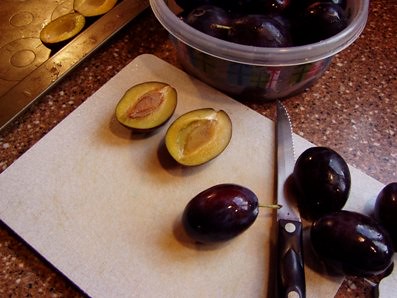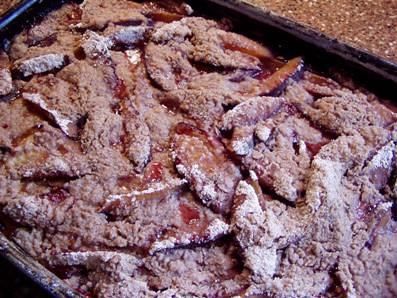 We were gifted recently with some plums from the local farmers market that was left over at the end of the day. The DH got first pick to make some plum wine (which is still percolating away in its jugs in the corner of the kitchen, under a box to protect it from the light) and I was faced with a whole lotta plum love. Invariably, a great deal of fruit or veggies arrive when I have the least amount of time to deal with them. In the old days, before Aunt Toby ‘got religion’, I’d putter along trying to do a little every night to get them done.
We were gifted recently with some plums from the local farmers market that was left over at the end of the day. The DH got first pick to make some plum wine (which is still percolating away in its jugs in the corner of the kitchen, under a box to protect it from the light) and I was faced with a whole lotta plum love. Invariably, a great deal of fruit or veggies arrive when I have the least amount of time to deal with them. In the old days, before Aunt Toby ‘got religion’, I’d putter along trying to do a little every night to get them done.
And a got a little done…and a lot ended up, shamefully, on the compost heap.
So, for today’s plums, because I’ve got a million things (like everyone else), I did this:
1) Washed all the plums.
2) Set aside some plums for German Plum Cake (see below)
3) Took out a cookie sheet, greased it a teeny bit to prevent sticking, cut the plums in halves, put them on the cookie sheet and stuck them in the freezer. When they are frozen, I’ll put them into a ziplock ™ bag. Do I have a specific plan for them? Actually, no, but I can make jam or preserves with them, bake with them, even just eat them defrosted, but at least they are taken care of. Plums are the easiest stone fruit to deal with: Just cut in half, take apart, and flick out the flat, eye-shaped pit. Nothing like dealing with cherries or peaches. Neat and very tidy.
But, to the cake. This is a modification of the German Plum Cake from recipezaar.com. To call this a ‘cake’ in the way that we understand the concept here in the United States is a little confusing. To Americans, all forms of ‘cake’ are the same: spongy, light, with some sort of thick frosting or sweet sauce or fluffy sweetened something all over it. This German Plum Cake is technically referred to as Pflaumenkuchen (don’t you just love those German cooking names – you can practically taste the thing when you say it – Flou-men-koo-ch–like you’re clearing your throat—en). Cooks with any mileage in the kitchen will recognize that this is NOT your father’s birthday cake when you read the list of ingredients. German Plum Cake
• 1/4 lb butter
• 1/3 cup sugar
• 1/2 teaspoon vanilla
• 1 egg
• 1 tablespoon sour cream
• 1 pinch salt (only if you use unsalted butter)
• 1 teaspoon ground lemon rind
• 1 3/4 cups flour
• 1 teaspoon baking powder
• 2 cups plums, pitted and sliced into thin wedges
For the topping
• 6 tablespoons butter
• 3/4 cup flour
• 1/3 cup sugar
• 1/2 teaspoon cinnamon
1. In a large bowl, cream the butter, add the sugar, vanilla, egg, lemon peel, sour cream and salt (if desired).
2. Mix the flour and baking powder and add that into the mixture.
3. Grease the base of a round baking pan and spread the dough over the pan.
4. Liberally spread plums over the dough.
5. To make the optional topping, cream the butter, add flour, sugar and cinnamon.
6. Sprinkle over the plums and bake for 30-45 minutes in the middle rack at 375 F.
7. Serve with lots of freshly-made whipped cream.
8. If you like, you may also sprinkle rum or cinnamon over the fruit before baking.

Now if you do this straight, according to the recipe, what you get is really almost like the dough you press into a pan to make bar cookies with. It ends up being held together with the butter/sugar/ juices from the plums. Like many Central European ‘treats’, it’s meant to be eaten in quite small slices. I’d rather have something more like a dense brownie on the bottom, so instead of 1 table spoon of sour cream (which I did not have), I added a half cup of vanilla yoghurt (I had Greek style in the fridge which has twice as much protein as the regular low fat stuff and has 0% fat, so I can do the ‘Oh what a good girl am I” thing). That made the dough much closer to brownies in density. I just emptied the bowl into the greased pan, put the sliced up plums on top and the topping and let ‘er bake.
This is, I’m afraid, a very grown up dessert and definitely in the European mold. And by that, I’m not referring to the rum that they are suggesting you sprinkle on the fruit (actually, I sprinkled a teaspoon of powdered ginger and a teaspoon of ground cinnamon on mine before I put the topping on . I LOVE ginger). Check out the amount of sugar as compared to a standard cake baked here: 1/3 cup of sugar to a stick of butter – which is a half cup of shortening and an egg. The standard ‘throw it together at the last minute’ cake recipe in the US would be 1.25 cups of sugar, ½ cup of shortening, and 2 eggs.  You can see that the fat to sugar ratio is totally different and makes for a dessert that depends much more on the quality of the fruit and the crumb topping for sweetness than what we expect from a standard cake here in the United States, which generally depends as much on the sweetness in the cake itself as it does on the sugar in the filling between the layers (if it’s a layer cake) and/or the frosting or topping. And considering that half of the calories in the dessert come from the butter, this is a calorie dense treat indeed. A small slice with a cup of coffee or tea would definitely round out a meal — we are definitely not talking about the standard “fill the plate and share it with two of your friends” serving of a piece of cake that gets presented in the US. A bit of a ‘dainty’ as they might say.
You can see that the fat to sugar ratio is totally different and makes for a dessert that depends much more on the quality of the fruit and the crumb topping for sweetness than what we expect from a standard cake here in the United States, which generally depends as much on the sweetness in the cake itself as it does on the sugar in the filling between the layers (if it’s a layer cake) and/or the frosting or topping. And considering that half of the calories in the dessert come from the butter, this is a calorie dense treat indeed. A small slice with a cup of coffee or tea would definitely round out a meal — we are definitely not talking about the standard “fill the plate and share it with two of your friends” serving of a piece of cake that gets presented in the US. A bit of a ‘dainty’ as they might say.
So, take out the nice china, brew up some lovely coffee or tea and enjoy.
